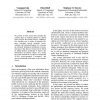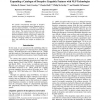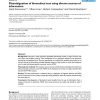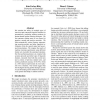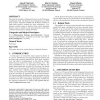ACL
2012
12 years 5 months ago
2012
In this paper, we develop an RST-style textlevel discourse parser, based on the HILDA discourse parser (Hernault et al., 2010b). We significantly improve its tree-building step b...
ACL
2011
13 years 6 months ago
2011
We present an NLP system that classifies the assertion type of medical problems in clinical notes used for the Fourth i2b2/VA Challenge. Our classifier uses a variety of linguisti...
FLAIRS
2009
14 years 13 days ago
2009
We evaluate conversational transcripts of deceptive speech using a sophisticated natural language processing tool called Coh-Metrix. Coh-Metrix is unique in that it tracks linguis...
ACL
2010
14 years 21 days ago
2010
Automatic error detection is desired in the post-processing to improve machine translation quality. The previous work is largely based on confidence estimation using system-based ...
BMCBI
2008
14 years 2 months ago
2008
Background: Like text in other domains, biomedical documents contain a range of terms with more than one possible meaning. These ambiguities form a significant obstacle to the aut...
NAACL
2004
14 years 4 months ago
2004
We examine the utility of multiple types of turn-level and contextual linguistic features for automatically predicting student emotions in human-human spoken tutoring dialogues. W...
ACL
2004
14 years 4 months ago
2004
We discuss Feature Latent Semantic Analysis (FLSA), an extension to Latent Semantic Analysis (LSA). LSA is a statistical method that is ordinarily trained on words only; FLSA adds...
AIRWEB
2008
Springer
14 years 4 months ago
2008
Springer
We study the usability of linguistic features in the Web spam classification task. The features were computed on two Web spam corpora: Webspam-Uk2006 and Webspam-Uk2007, we make t...
FLAIRS
2010
14 years 5 months ago
2010
This study examines the linguistic features of freewrites and how those features relate to human scores of freewrite quality. Freewriting is a common prewriting strategy that has ...
SIGIR
2005
ACM
14 years 8 months ago
2005
ACM
This paper presents a new discriminative model for information retrieval (IR), referred to as linear discriminant model (LDM), which provides a flexible framework to incorporate a...

